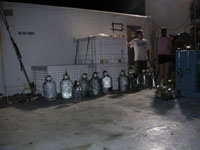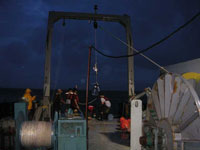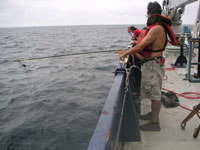


|
The Project Part 1: Part 2: Part 3:
|
29 July, 2005
|
 Preparing the carboy suspension line on the back deck  The carboys ready to be sent below the ocean surface  The array goes in the water  Fishing for trace metals |
More from The Log from the Sea of Cortez
A tide pool has been called a world under a rock, and so it might be said of navigation, it is the world within the horizon.
This morning the horizon is ringed by haze and towering clouds; dolphins circle the ship (we thought they were sharks at first) and the heat has lessened somewhat. Rain spatters on the decks outside. We can see no land. Occasionally a fishing boat appears on the horizon.
Today the R/V New Horizon will stay in a stationary position. We are doing this because we are sticking close to the array that was put in the water just before sunrise. We got up at 1:45 am, took water samples, processed the water and then returned it to the ocean in large bottles called carboys. The carboys are set back in the sea, as close as possible from where they were originally taken.
The word carboy comes to us from a language far removed from English. Can you guess which one? The answer will be posted tomorrow.
An array is a type of incubator. It is a long rope studded with hooks that hold the carboys suspended in the water. The scientists do this to measure any changes that will occur in the phytoplankton over a 24-hour period. They have added chemicals to the water (nitrogen and 13carbon- pronounced carbon thirteen). An examination of the phytoplankton will measure how much of the added chemicals the microscopic plants have used. This experiment isolates (in the carboy) a piece of the natural environment and what happens there. Most of the water samples will be filtered and sent to a lab in Hawaii for analysis.
Another experiment is being conducted off the starboard side. Chris studies trace metals. The equipment he uses to recover water looks like an odd-shaped fishing pole.
Space Limitations on Ships:
I must say I was worried about being confined on the ship living in close quarters. There is little real privacy. How does one find some solitude confined with 30 people you don’t know? Surprisingly, you can have a bit of private space because everyone respects what little space is available. There are a few chairs on deck where we can sit alone to read or just gaze at the water. Rob, the resident technician (he keeps all the electronics that the scientists are using humming), has a hammock he can string across the fantail (back deck) or up in the bow (front) of the ship. Our bunks each have short curtains that create a small private haven. The constant humming of the engines and the slap of waves against the ship also drown out voices and activity. This, too, helps to create a sense of personal space.
Math Problem: Look up the latitude and longitude of Astoria OR. Latitude and longitude are measured in degrees, which then are broken into minutes and seconds. There are 60 minutes in one degree of latitude, and each minute equals 1.15 nautical miles.
- Look up the latitude and longitude of Astoria, Oregon (or wherever you are). How far north is Astoria from the Equator (in degrees)?
- How many miles is Astoria from the Equator?
Look for more work on latitude and longitude to come!
Trivia Tidbit of the Day:
Do penguins have knees? Yes, we just can’t see them under all those feathers.
![]()
